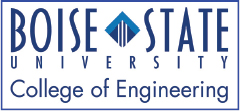FUSE (First Undergraduate Service learning Experience): Real-World Adaptive Engineering Design
Lead Institution: Boise State University, Boise, ID
Collaborating Institutions: Non-profit and community organizations
Category: First Year/Service Learning
Date Implemented: Spring 2009
Website: http://coen.boisestate.edu/fuse


Program Description: The Introduction to Engineering course is a project-based lab course designed to provide students greater insights into the activities and challenges that engineers in all disciplines encounter in their jobs. A service learning option, FUSE (First Undergraduate Service learning Experience): Real-World Adaptive Engineering Design, was added to the course during the spring 2009 semester and focuses on adaptive technology design where students modify or adapt equipment for a person with a disability. Students have disability awareness training before arranging their first client meeting and spend the last half of the semester working in teams to understand the problem and develop a solution. Clients work closely with students throughout the project to help them fully understand the problem, evaluate design options and prototypes, and ensure a successful solution. Students are required to brainstorm multiple design options and evaluate them as to which is most likely to meet the project requirements, cost, and schedule goals. They are encouraged to develop prototypes using inexpensive, readily available materials and use them to conduct functionality testing to further verify the design. The results of these tests allow students to refine their product plans and increase the chances of success with their final product. Projects are carefully screened for scope and scale to ensure students have the time and ability to successfully complete them. Consultants and mentors from the university and community are available to students. Over 60 projects have been completed, and students experience tremendous satisfaction when they are able to see tangible results of their efforts, solve a “real” problem, understand the impact they have had on their client’s quality of life, and see a project through to completion. Several students have offered support to their client long after the class has ended. For each non-profit and community organization, there is a personal point of contact serving as liaison. Relationships with people at these organizations, coupled with successful completion of projects, are key to building the program.
Anticipated and Actual Outcomes: The objectives are for students to: (1) discover the creativity, challenge, and rewards in solving an engineering problem; (2) apply critical thinking and problem-solving skills using the engineering design process, to identify, analyze, and solve a problem from the community; (3) practice the skills necessary to be a successful engineer, including project management skills, working on a multi-disciplinary team, and communicating within a project team, with instructors, with clients, with community partners, and with industry experts; (4) contribute to the community; and (5) better understand themselves, including their strengths and weaknesses, by reflecting upon these experiences. FUSE is assessed using self-reflections, team member evaluations, self-evaluation, client evaluations, consultant/instructor design reviews, and evaluation of project deliverables required at each milestone in the design process. Most students develop a strong rapport with clients and design a customized solution to meet their needs. Understanding the benefit of their work for the client often motivates students to put forth more effort than for a normal class project.
Assessment Information: We investigated the effectiveness of using service-learning (SL) compared to non-service-learning (NSL) on influencing introductory engineering students’ (1) motivational attitudes toward collaborative project-based learning and (2) self-assessment of engineering abilities measured against ABET outcomes. The motivational attitudes investigated were interest in learning, relevance of learning, confidence in engineering knowledge, confidence in collaborative learning, and satisfaction in learning. Significant changes in student engagement in class activities and ability to work with team members were noted in several students as they worked with their client in solving a problem. Results showed that the SL method was significantly more effective than the NSL method in terms of positively influencing students’ motivational attitudes toward collaborative project-based learning and improving self-assessment of abilities. Follow-on research showed that SL students’ motivation, interest in learning, relevance of learning, and satisfaction in learning scores were significantly higher than NSL students’ scores. SL students’ confidence levels in their engineering knowledge and collaborative learning were higher than NSL students’, but the differences were not statistically significant. SL students’ self-assessed engineering abilities were higher than the NSL students’ in c, e, and k ABET outcomes.
Funding/Sustainability: Because the instructor was already a full-time employee, there was only incremental additional cost, approximately $50/student, associated with adding the SL program to the existing course. Funds for the first semester pilot program were provided by an internal university grant for approximately $1200. Existing laboratory space, fabrication equipment, and resources were shared with other programs with no costs incurred. The College’s long-term goal is to solicit funds from alumni and private individuals to help sustain and grow the program. In the near term, the program will be funded at the current rate with general funds and donations of goods and services from the community. FUSE has its own course name, number, and an extra credit hour so students receive credit for the extra work. This allows our college to pay adjuncts who sponsor a section and makes it easier to schedule as it increases the visibility as a distinct course offering.

